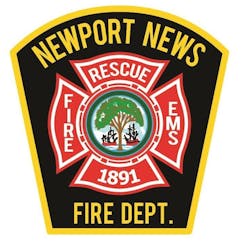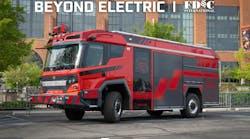Between the scene of an accident or emergency, Newport News medics now can get a view that can shave valuable seconds off of response and treatment — a view inside a patient’s chest and abdomen.
For about three months, the department has been using portable ultrasound devices to check organs and look for internal bleeding in a patient after they’ve been in some sort of traumatic accident, like a car crash, or medical emergency, like a heart attack.
“That quick peek inside helps with decision-making and lets us relay information to the emergency room to get them up to speed,” said Eric Gaskins, an emergency medical service captain for the department.
Looking into the patient’s torso in the ambulance on the way to the hospital can save a step and valuable time.
“A few seconds make a big difference,” Gaskins said.
The Newport News Fire Department is one of about 30 in the country using similar ultrasound devices in EMS and the only one in the region, according to department staff.
"We’re pretty cutting edge, said Gaskins, who also works as a paramedic on the Nightingale Helicopter. The Nightingale medics have had ultrasound devices onboard for about five years, but they’re not as advanced as the model, manufactured by the Butterfly Network, that Newport News is using.
The ultrasound tools are sleek and compact, consisting of the barber clipper-sized device that captures the images and an iPad. It all fits with room to spare in a laptop bag.
Gaskins said older models required more parts, each dedicated to a different type of reading. They also cost more — each device could go for up to $8,000. The department bought its devices for about $2,000 apiece.
Gaskins said the device allows medics to check for issues such as a ruptured bladder, which a seat belt can cause in a crash, collapsed lungs and blood pooling around the heart.
Robert E. Lee, the assistant fire chief in charge of EMS, said there was a car crash in December where the patient didn’t have many external signs of injury, but the ultrasound revealed the patient had lacerations on their liver. Getting that information took about a minute once they were in the ambulance.
Without the ultrasound, doctors at the hospital wouldn’t have known about that injury until after the ambulance trip and after getting the patient to a hospital ultrasound.
About 20 firefighters are trained to use the ultrasounds, and at least three are always on duty, one in each district of the city.
Ray Brumfield, an EMS captain who also serves on the department’s purchasing committee, said he’s eyeing a similar ultrasound device he’s seen departments in Sweden using to look into a person’s head. Those could be valuable when treating a stroke patient or someone who may have suffered a brain injury, he said.
Brumfield demonstrated the device on a firefighter in Fire Station 1 in downtown, applying a gel to his abdomen and going around to show the firefighter’s kidneys, heart and lungs.
Images appeared on the tablet within seconds, and the firefighter was deemed well enough to continue with his duties.
———
©2019 the Daily Press (Newport News, Va.)
Visit the Daily Press (Newport News, Va.) at www.dailypress.com
Distributed by Tribune Content Agency, LLC.






